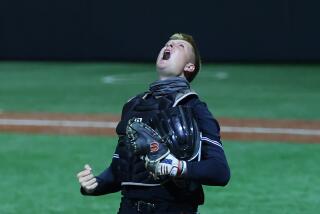Now that minor league baseball is back in L.A. County for the first time since the 1950s fans are ready to hear . . . Play Ball
- Share via
When the Lancaster JetHawks play the Visalia Oaks in a California League game at The Hangar on Tuesday night, it will mark the first time an affiliated minor league team based in Los Angeles County has played a home game since 1957, before the Dodgers came to California.
So it’s a pretty safe bet many fans in the region haven’t been to a minor league baseball game. What have they missed?
As for the baseball, not much. Major league baseball provides a higher quality game, though there is more of a difference in consistency than skill.
But the minors have surpassed the majors in, well, just about everything else.
Want a great seat for $5? Want to see some guys who hardly ever turn down a request for an autograph? Want to see your 5-year-old daughter have a chance to run around on the field in front of thousands of fans?
Want to get a haircut?
Fans can get one without missing a pitch at a JetHawk game. Such promotions have defined the minor league game in the 1990s.
“I think the difference between a minor league game and a major league game is we are more than just a baseball game,” said JetHawk General Manager Matt Ellis. “Minor league baseball is an experience. It’s a way for a family to come out for an affordable price that includes baseball and a lot of fun promotions that we do every night.”
Among the more original California League promotions is in San Jose, where each night a visiting batter is chosen as the “beer batter.” If that player strikes out, beer is half price for 15 minutes.
At High Desert, after a Maverick player hits a home run, a hat is literally passed around the crowd for donations for the player. Not a bad supplement considering most Cal League players make about $1,200 a month and get $18 a day for meal money on the road. Major league players get close to $80 a day for meals.
Among promotions that have become staples of minor league baseball is the mascot race, in which some lucky kid from the crowd lines up to race a big goofy mascot around the bases between innings. Somehow, no matter how far behind the child starts, he or she always seems to win.
Another common promotion is bingo, in which everything that happens on the field corresponds to a spot on a bingo card. Or the old throw-a-ball-through-a-hole-and-win-a-prize. Most new minor league parks also have picnic areas and carnival-type games.
If a good general manager has his way, fans can attend a minor league baseball game and not even watch baseball.
It’s not that they don’t want you to watch the team, but since they have no control over the product on the field--major league clubs control that for their affiliates--the minor league teams turn to promotions instead.
And besides, who’s going to pay to see Jason Cook anyway? (He’s the JetHawks second baseman.)
“We don’t offer what [the majors] offers,” Ellis said. “We don’t offer Barry Bonds. We offer the Barry Bonds of the future, but that’s hard to sell.”
Marketing mostly anonymous minor league players is nearly impossible. They come from all over and usually don’t stay with a team more than one season. By the mere nature of the minors, the better the player, the less time he stays with one team.
The misconception about minor leaguer players is that they aren’t as good as major leaguers.
They are. Just not as often.
“These guys were all drafted because they have major league tools,” said JetHawk Manager Dave Brundage. “The difference is consistency. Look at a guy like [JetHawk third baseman] Carlos Villalobos. He will make some plays that guys in the bigs can’t make, but he can’t make them consistently.”
The minors are full of guys like Villalobos, who make spectacular plays one minute, then boot routine grounders the next. Or pitchers like JetHawk Ivan Montane, who can strike out five consecutive batters with major league-quality sliders, then walk four in a row.
Most California League teams have two or three players who will eventually hone their skills enough to play in the majors.
The goal of making the major leagues is, after all, the reason the players are in the minors, and that has to be taken into consideration while watching a game. There are often situations in which what’s best for the development of a player isn’t what is best for a minor league team.
Pitchers throwing brilliant games will often be pulled after five innings because the major league teams limit their pitches to prevent injury.
Slumping hitters will sometimes bat in key situations because the major league team wants them to learn to produce under pressure.
Players will play positions at which they are clumsy and uncomfortable because they need to learn a new position to fit a hole in the majors.
Occasionally a minor league game will be flawlessly played, but more often a few outstanding plays will be surrounded by several walks and errors.
Sometimes it isn’t pretty. But it is affordable--and entertaining.
More to Read
Go beyond the scoreboard
Get the latest on L.A.'s teams in the daily Sports Report newsletter.
You may occasionally receive promotional content from the Los Angeles Times.










